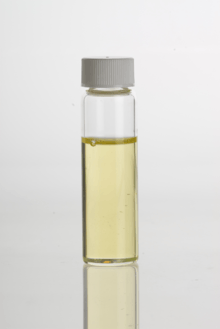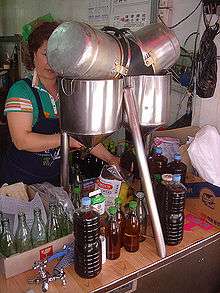Sesame oil
 Sesame seed oil in clear glass vial | |
| Nutritional value per 100 g (3.5 oz) | |
|---|---|
| Energy | 3,699 kJ (884 kcal) |
|
0.00 g | |
|
100.00 g | |
| Saturated | 14.200 g |
| Monounsaturated | 39.700 g |
| Polyunsaturated | 41.700 g |
|
0.00 g | |
| Vitamins | |
| Vitamin C |
(0%) 0.0 mg |
| Vitamin E |
(9%) 1.40 mg |
| Vitamin K |
(13%) 13.6 μg |
| Minerals | |
| Calcium |
(0%) 0 mg |
| Iron |
(0%) 0.00 mg |
| Magnesium |
(0%) 0 mg |
| Phosphorus |
(0%) 0 mg |
| Potassium |
(0%) 0 mg |
| Sodium |
(0%) 0 mg |
|
| |
| |
|
Percentages are roughly approximated using US recommendations for adults. Source: USDA Nutrient Database | |
Sesame oil is an edible vegetable oil derived from sesame seeds. Besides being used as a cooking oil in South India, it is often used as a flavour enhancer in Korean, Chinese, Japanese, Middle Eastern, and Southeast Asian cuisine. It has a distinctive nutty aroma and taste.[1]
The oil from the nutrient-rich seed is popular in alternative medicine, from traditional massages and treatments to the modern day.
The oil is popular in Asia and is also one of the earliest-known crop-based oils, but world-wide mass modern production continues to be limited even today due to the inefficient manual harvesting process required to extract the oil.
Composition
Sesame oil is composed of the following fatty acids: linoleic acid (41% of total), oleic acid (39%), palmitic acid (8%), stearic acid (5%) and others in small amounts.[2]
History

Historically, sesame was cultivated more than 5000 years ago as a drought-tolerant crop and was able to grow where other crops failed.[3][4] Sesame seeds were one of the first crops processed for oil as well as one of the earliest condiments. Sesame was cultivated during the Indus valley civilization and was the main oil crop. It was probably exported to Mesopotamia around 2500 BC.[5][6]
Sesame oil is thought to have originated in the Indus Valley of North India, but spread from there throughout Asia.
Manufacture
Manufacturing process


Sesame seeds are protected by a capsule which only bursts when the seeds are completely ripe. This is called dehiscence. The dehiscence time tends to vary, so farmers cut plants by hand and place them together in an upright position to continue ripening until all the capsules have opened. The discovery of an indehiscent mutant (analogous to nonshattering domestic grains) by Langham in 1943 began the work towards development of a high-yielding, dehiscence-resistant variety. Although researchers have made significant progress in sesame breeding, harvest losses due to dehiscence continue to limit domestic US production.[7]
Sesame seeds are primarily produced in developing countries, a factor that has played a role in limiting the creation of large-scale, fully automated oil extraction and processing techniques.[8] Sesame oil can be extracted by a number of methods, depending on the materials and equipment available.
In developing countries, sesame oil is often extracted with less-expensive and manually intensive techniques such as hot water flotation, bridge presses, ram presses, the ghani process, or by using a small-scale expeller. In developed countries sesame oil is often extracted using an expeller press, larger-scale oil extraction machines, or by pressing followed by chemical solvent extraction.[8]
Sesame oil can also be extracted under low-temperature conditions using an expeller press in a process called cold pressing. This extraction method is popular among raw food adherents because it avoids exposing the oil to chemical solvents or high temperatures during extraction.
While some manufacturers will further refine sesame oil through solvent extraction, neutralization and bleaching in order to improve its cosmetic aspects, sesame oil derived from quality seeds already possesses a pleasant taste and does not require further purification before it can be consumed. Many consumers prefer unrefined sesame oil due to their belief that the refining process removes important nutrients. Flavour, which was traditionally an important attribute was best in oils produced from mild crushing.[9]
Sesame oil is one of the more stable natural oils, but can still benefit from refrigeration and limited exposure to light and high temperatures during extraction, processing and storage in order to minimize nutrient loss through oxidation and rancidity. Storage in amber-colored bottles can help to minimize light exposure.
Sesame oil is a polyunsaturated (PUFA) semi-drying oil. Commercial sesame oil varies in colour from light to deep reddish yellow depending on the colour of the seed processed and the method of milling. Provided the oil is milled from well-cleaned seed, it can be refined and bleached easily to yield a light-coloured limpid oil. Sesame oil is rich in oleic and linoleic acids, which together account for 85% of the total fatty acids. Sesame oil has a relatively high percentage of unsaponifiable matter (1.5-2.3%) in India and in some other European countries. It is obligatory to add sesame oil (5-10%) to margarine and generally to hydrogenated vegetable fats which are commonly used as adulterants for butter or ghee.
Sesame seed market
The market for sesame oil is mainly located in Asia and the Middle East where the use of domestically produced sesame oil has been a tradition for centuries.[7] About 65 percent of the annual US sesame crop is processed into oil and 35 percent is used in food.[10]
Varieties
There are many variations in the colour of sesame oil: cold-pressed sesame oil is pale yellow, while Indian sesame oil (gingelly or til oil) is golden, and East Asian sesame oils are commonly a dark brown colour. This dark colour and flavour are derived from roasted/toasted sesame seeds. Cold pressed sesame oil has a different flavour than the toasted oil, since it is produced directly from raw, rather than toasted, seeds.
Sesame oil is traded in any of the forms described above: Cold-pressed sesame oil is available in Western health shops. Unroasted (but not necessarily cold pressed) sesame oil is commonly used for cooking in South India, the Middle East, halal markets and East Asian countries.[11]
Nutrients
The only essential nutrient having significant content in sesame oil is vitamin K, providing 17% of the Daily Value per 100 grams (ml) consumed supplying 884 calories (table). For fats, sesame oil is approximately equal in monounsaturated (oleic acid) and polyunsaturated (linoleic acid) fats, totaling together 80% of the fat content (above table). The remaining oil content is primarily the saturated fat, palmitic acid (about 9% of total, table).
Uses
Cooking
One type of sesame oil, a pale yellow liquid with a pleasant grain-like odor and somewhat nutty taste is used as frying oil.[10] A second type of oil, amber-colored and aromatic, is made from pressed and toasted sesame seeds. Although popular in ethnic cooking, it is not suitable as a cooking oil because it burns readily.[10] Instead, amber sesame oil is normally added as a flavoring agent in the final stages of cooking.
Despite sesame oil's high proportion (41%) of polyunsaturated (Omega-6) fatty acids, it is least prone, among cooking oils with high smoke points, to turn rancid when kept in the open.[7][10] This is due to the natural antioxidants, such as sesamol, present in the oil.[10]
Light sesame oil has a high smoke point and is suitable for deep-frying, while dark sesame oil (from roasted sesame seeds) has a slightly lower smoke point and is unsuitable for deep-frying.[10] Instead it can be used for the stir frying of meats or vegetables, sautéing, or for the making of an omelette.
Sesame oil is most popular in Asia, especially in Korea, China, and the South Indian states of Karnataka, Andhra Pradesh, and Tamil Nadu, where its widespread use is similar to that of olive oil in the Mediterranean.
- East Asian cuisines often use roasted sesame oil for seasoning.
- The Chinese use sesame oil in the preparation of meals.
- In Japan, rāyu, is a paste made of chili-sesame oil seasoning - and used as a spicy topping on various foods - or mixed with vinegar and soy sauce - and used as a dip.
- In South India - before the advent of modern refined oils produced on a large scale, sesame oil was used traditionally for curries and gravies. It continues to be used, particularly in Tamil Nadu and Andhra Pradesh, mixed with foods that are hot and spicy as it neutralizes the heat. It is often mixed in with a special spice powder that accompanies idli, dosa as well as rice mixed with spice powders (such as paruppu podi).
Traditional uses
In Ayurvedic medicine, sesame oil (til tel) is used for massaging as it is believed to rid the body of heat due to its viscous nature upon rubbing.[12] It is also used for hair and scalp massage. It is also used in many cosmetic applications, including as a carrier oil.
Industrial uses
In industry, sesame oil may be used as[7][10]
- a solvent in injected drugs or intravenous drip solutions,
- a cosmetics carrier oil,
- coating stored grains to prevent weevil attacks. The oil also has synergy with some insecticides.[13]
Low grade oil is used locally in soaps, paints, lubricants, and illuminants.[10]
Allergy
As with numerous seed and nut foods, sesame oil may produce an allergic reaction, although the incidence of this effect is rare at approximately 0.1% of the population.[14][15] Reports of sesame allergy are growing in developed countries during the 21st century, with the allergic mechanism from oil exposure expressed as contact dermatitis, possibly resulting from hypersensitivity to lignin-like compounds.[14][16]
See also
References
| Wikimedia Commons has media related to Sesame oil. |
- ↑ Goldberg, Sharon (1995). "Sesame Oil, a featured ingredient". Flavor & Fortune.
- ↑ "Nutrition Facts for sesame oil per 100 g, analysis of fats and fatty acids". Conde Nast for the USDA National Nutrient Database, version SR-21. 2014. Retrieved 11 July 2015.
- ↑ Raghav Ram; David Catlin; Juan Romero & Craig Cowley (1990). "Sesame: New Approaches for Crop Improvement". Purdue University.
- ↑ D. Ray Langham. "Phenology of Sesame" (PDF). American Sesame Growers Association.
- ↑ "History and Lore of Sesame in Southwest Asia" (PDF).
- ↑ Small, Ernest (2004). "History and Lore of Sesame in Southwest Asia". Economic Botany. New York Botanical Garden Press. 58 (3): 329–353. doi:10.1663/0013-0001(2004)058[0329:AR]2.0.CO;2. JSTOR 4256831.
- 1 2 3 4 E.S. Oplinger, D.H. Putnam, A.R. Kaminski, C.V. Hanson, E.A. Oelke, E.E. Schulte, and J.D. Doll (May 1990). "Sesame". Center for New Crops & Plant Products, Purdue University, Department of Horticulture and Landscape Architecture.
- 1 2 Kamal-Eldin, Afaf; Appelqvist, Lars-Åke (1195). "The effects of extraction methods on sesame oil stability". Journal of the American Oil Chemists' Society. 72 (8): 967–969. doi:10.1007/BF02542076. Retrieved 2012-04-26.
- ↑ "Ghani: A traditional method of oil processing in India". United Nations, Food and Agriculture Organization, Document Repository. 1993.
- 1 2 3 4 5 6 7 8 "AgMRC Sesame profile". Ag Marketing Resource Center, Iowa State University, Ames, IA. 2016.
- ↑ Katzer G (17 December 1999). "Spice Pages: Sesame Seeds (Sesamum indicum)".
- ↑ Lahorkar P, Ramitha K, Bansal V, Anantha Narayana DB (2009). "A comparative evaluation of medicated oils prepared using ayurvedic and modified processes". Indian J Pharm Sci. 71 (6): 656–62. doi:10.4103/0250-474X.59548. PMID 20376219.
- ↑ Morris, JB (2002). "Food, Industrial, Nutraceutical, and Pharmaceutical Uses of Sesame Genetic Resources". Purdue University.
- 1 2 "Canadian Food Inspection Agency: Sesame Allergy". Health Canada. 31 August 2016. Retrieved 21 November 2016.
- ↑ Dalal I, Goldberg M, Katz Y (2012). "Sesame seed food allergy". Curr Allergy Asthma Rep. 12 (4): 339–45. doi:10.1007/s11882-012-0267-2. PMID 22610362.
- ↑ Gangur V, Kelly C, Navuluri L (2005). "Sesame allergy: a growing food allergy of global proportions?". Ann Allergy Asthma Immunol. 95 (1): 4–11. doi:10.1016/s1081-1206(10)61181-7. PMID 16095135.
